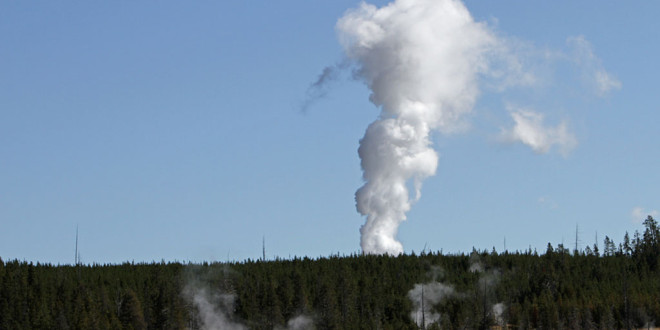Yellowstone Volcano Observatory scientists have confirmed that Steamboat Geyser, located in Norris Geyser Basin, erupted last week.
Steamboat, the world’s tallest active geyser—recorded eruptions have been as high as 300 feet—doesn’t erupt predictably or often.
Its last eruption was on Sept. 3, 2014, according to a recent announcement from Yellowstone’s Public Affairs Office.
Wendy Stovall, Ph.D., the deputy scientist in charge at the YVO, a branch of the United States Geological Survey, located in Vancouver, Washington, said the eruption was confirmed both by data collected on-site and later by observation by National Park Service staff.
The eruption occurred at 5:30 a.m. on Thursday, March 15.
“Nobody saw it,” Stovall said.
Park Service staff went out Friday, March 16 and confirmed the geyser was still producing a “vigorous” steam phase that was also observed Monday, March 19, but Stovall couldn’t confirm that the steam phase had been continuous all that time.
Part of the reason there are even remote sensors around the Norris Geyser Basin is because Norris is such a dynamic area. There is a lot of seismicity, or earthquake activity, and deformation around the geyser basin, Stovall said.
Crustal deformation “refers to the changing earth’s surface caused by tectonic forces that are accumulated in the crust and then cause earthquakes,” the USGS website explains.
“Measuring temperatures helps us measure what’s going on as a whole with the volcano of Yellowstone,” she said.
The YVO measures the temperatures of several different features at Norris, and those temperatures help measure what’s going on as a whole with the Yellowstone caldera. The sensors were installed in the year 2000, Stovall said.
There are temperature gauges downhill from Steamboat in its runoff channel a well as gauges further downstream in Tantalus Creek. Interestingly, when the equipment records temperature changes—after an eruption of any geyser, the water temperature in the creek increases—the temperature of the water can be correlated to which feature it emerged from, Stovall said.
The temperature sensors in Tantalus were also responsible to tipping observers off last October that Echinus Geyser, not far from Steamboat, had begun a short phase erupting semi-regularly again.
The temperature of the water from Steamboat allowed scientists to compute the eruption time of 5:30 a.m. Thursday, Stovall said.
Another sign of a Steamboat eruption is that a downhill, nearby pool, Cistern Spring, will also see changes, usually in a lower water level in the pool.
NPS employees were able to confirm Monday that Cistern did partially drain, Stovall said.
And the big question the YVO gets asked whenever something unusual happens in Yellowstone—like an swarm of minor earthquakes or the eruption of the world’s tallest geyser—is this one: “Is the caldera about to blow?”
Stovall laughs.
“This has no bearing on the magmatic system under Yellowstone,” she said emphatically.
Volcanoes all over the world have hydrothermal systems. She explained that if there were actual magma working its way to the surface, all the heat “rising to the top” would manifest as dried up geysers, hot springs and mudpots.
“Because all the water goes away from the heat coming up,” she explained. “As long as there’s water and the geysers and hot springs and mud pots are still boiling, everything is fine.”
 Yellowstone Insider Your Complete Guide to America's First National Park
Yellowstone Insider Your Complete Guide to America's First National Park





